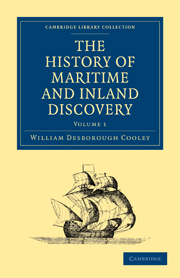Book contents
- Frontmatter
- Contents
- BOOK I GEOGRAPHY OF THE ANCIENTS
- CHAP. I
- CHAP. II THE GREEKS. — HOMERIC AGE
- CHAP. III GREEKS CONTINUED.—HISTORIC AGE
- CHAP. IV THE GREEKS CONTINUED
- CHAP. V GREEKS CONTINUED
- CHAP. VI THE GREEKS CONTINUED
- CHAP. VII DISCOVERY OF THE MONSOONS
- CHAP. VIII PTOLEMY
- CHAP. IX ON THE COMMERCE OP THE ANCIENTS
- CHAP. X MYTHIC GEOGRAPHY OP THE HINDOOS, AND ITS CONNECTION WITH GRECIAN MYTHS
- BOOK II GEOGRAPHY OF THE MIDDLE AGES
- BOOK III PROGRESS OF GEOGRAPHY IN THE MIDDLE AGES
CHAP. VII - DISCOVERY OF THE MONSOONS
Published online by Cambridge University Press: 05 July 2011
- Frontmatter
- Contents
- BOOK I GEOGRAPHY OF THE ANCIENTS
- CHAP. I
- CHAP. II THE GREEKS. — HOMERIC AGE
- CHAP. III GREEKS CONTINUED.—HISTORIC AGE
- CHAP. IV THE GREEKS CONTINUED
- CHAP. V GREEKS CONTINUED
- CHAP. VI THE GREEKS CONTINUED
- CHAP. VII DISCOVERY OF THE MONSOONS
- CHAP. VIII PTOLEMY
- CHAP. IX ON THE COMMERCE OP THE ANCIENTS
- CHAP. X MYTHIC GEOGRAPHY OP THE HINDOOS, AND ITS CONNECTION WITH GRECIAN MYTHS
- BOOK II GEOGRAPHY OF THE MIDDLE AGES
- BOOK III PROGRESS OF GEOGRAPHY IN THE MIDDLE AGES
Summary
But, towards the East, a discovery was made in the age of Pliny, by an obscure individual, of far greater importance to geography and commerce than the temporary routes laid open into barbarous countries by the hardihood and ambition of the Roman generals. The regularity of the monsoons, or periodical winds, which, in the seas between Africa and India blow during one half of the year from the south-west, and during the other from the south-east, with little deviation, could not have long escaped the attention of the Arabian navigators. No advantage, however, was taken of this striking phenomenon; for among an uncultivated people time operates slowly in maturing the details of partial experience into acknowledged principles. The Greeks, however, soon learned to estimate its importance. We have seen that the voyage of Eudoxus to India originated in the circumstance of an Indian vessel being driven upon the coast of Africa by the prevalence of the easterly monsoon: Eudoxus himself, on his return to Egypt, was forced too far to the west by the same wind. Jambolo, on the other hand, was said to have been carried by the westerly monsoon from Africa to Ceylon; and again in the reign of the emperor Claudius, a freed-man of Annius Plocamus, employed in collecting the revenues of Arabia, was driven in like manner to the same island.
- Type
- Chapter
- Information
- The History of Maritime and Inland Discovery , pp. 100 - 104Publisher: Cambridge University PressPrint publication year: 2010First published in: 1830



